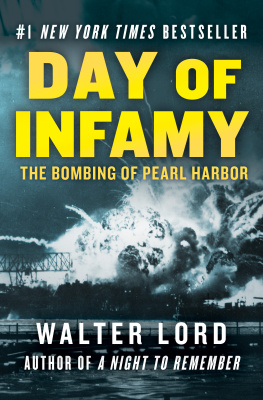Trapped at Pearl Harbor

The latest edition of this work has been brought to publication with the generous assistance of Marguerite and Gerry Lenfest.
Naval Institute Press
291 Wood Road
Annapolis, MD 21402
1991 by Stephen Bower Young
All rights reserved. No part of this book may be reproduced or utilized in any form or by any means, electronic or mechanical, including photocopying and recording, or by any information storage and retrieval system, without permission in writing from the publisher.
First Bluejacket Books printing, 1998
ISBN: 978-1-61251-249-5 (eBook)
The Library of Congress has cataloged the hard cover edition as follows:
Young, Stephen Bower.
Trapped at Pearl Harbor : escape from Battleship Oklahoma / Stephen Bower Young.
p. cm.
Includes index.
1. Young, Stephen Bower. 2. Oklahoma (Battleship) 3. World War 19391945Personal narratives, American. 4. Pearl Harbor (Hawaii), Attack on, 1941. 5. United States. NavyGunnersBiography.
6. SeamenUnited StatesBiography. I. Title.
D774.04Y68 1991
940.5426dc20

 Print editions meet the requirements of ANSI/NISO z39.48-1992 (Permanence of Paper).
Print editions meet the requirements of ANSI/NISO z39.48-1992 (Permanence of Paper).
16 15 14 13 10 9 8 7
To the sailors and marines who lost their lives on board the ships in Pearl Harbor, Territory of Hawaii, on 7 December 1941, and in particular those men of the battleship Oklahomas 4th deck division and the crew of no. 4 gun turret
When I have fears that I may cease to be
Before my pen has gleaned my teeming brain,
Before high-piled books, in charactry,
Hold like rich garners the full-ripened grain;
When I behold, upon the nights starred face,
Huge cloudy symbols of a high romance,
And think that I may never live to trace
Their shadows, with the magic hand of chance;
And when I feel, fair creature of an hour,
That I shall never look upon thee more,
Never have relish in the faery power
Of unreflecting love! then on the shore
Of the wide world I stand alone, and think
Till Love and Fame to nothingness do sink.
JOHN KEATS
Contents


T his account is a true and faithful report on the lives of a few dozen sailors, members of the 14-inch gun crew of the battleship Oklahomas turret no. 4, and some others, mostly young, who were caught up in the swirl of a world at war on a sunny Sunday morning in Hawaii, 7 December 1941. The assault took place when a daring Japanese carrier force invaded the friendly waters of the islands and in a surprise attack smashed the mighty U.S. Pacific Fleet at its moorings in Pearl Harbor on the island of Oahu.
Fifty years have passed since the events I am about to relate took place. Despite the passage of time, it seems like yesterday. My mind sees clearly the shipmates I knew so well as they emerge, laughing and talking, from a hatch, port side, main deck, aft, of the Oklahoma. It is time for morning quarters for muster, and at the urging of their petty officers, the white-uniformed sailors good-naturedly form into double ranks. They stand at ease by the after gun turret, squaring round hats over suntanned faces, waiting for the arrival of their division officers.
I see and recognize each man, though the faces of some seem to be in shadow as if a cloud in the bright Hawaiian sky had sought them out by chance. As if aware of my presence, one of the sailors cast in shadow looks directly at me, smiling briefly in momentary recognition over the intervening years, then looks back at his companions. Their talk is animated and they turn in my direction. Then the cloud grows darker and I see those certain few less clearly.
The image fades as I look out over my native New England countryside, so far removed in geography and time. For me, those carefree American sailors standing there on the Oklahomas fantail are very real and will remain forever young, as I knew them in the peacetime days of 194041.
It is in memory of those brave and not so brave men who foughtand some who diedon that Sunday morning in Hawaii so far from home that I have written this account.
M y thanks to the survivors of the Oklahomas turret no. 4 and some others, without whose recollections and contributions this account could not have been written. Former Chief Gunners Mate Dick Whitman was kind enough to read the manuscript with a critical eye.
Particular thanks go to the late Gerald Dutch Foreman, a quartermaster in the Oklahoma and historian of the OKLAHOMA Association, for the use of material from his Quartermasters Notebook.
And to Paul Stillwell, formerly senior editor of the U.S. Naval Institute Proceedings and presently editor-in-chief of Naval History, for his encouragement and thorough reading of the first draft of the manuscript.
And also to a former sometime shipmate, the late Admiral Samuel Eliot Morison, distinguished naval historian and Harvard professor, for his help and understanding. We served together in the light cruiser Honolulu during several combat operations in the South Pacific, while he was researching and writing his history of the naval operations in World War II. I was a quartermaster petty officer, a member of ships company. We formed a friendship that was renewed when we returned to Harvard after the war. Admiral Morison and Captain Herbert Rommel started me on the long process of writing this book, the latter by giving me the list of names of turret no. 4 personnel, the former by encouraging the Navy Department to supply the current addresses to match.
Trapped at Pearl Harbor
SATURDAY, 6 DECEMBER 1941
T he USS Oklahoma and most of the Pacific Fleet had been at sea on maneuvers and had only yesterday returned to port. It was the first time since the Okie had come out to Pearl Harbor earlier in the year that all the fleet battleships operating in the Hawaiian area had been ordered into port at the same time. On this first weekend in December there were eight in port, including Admiral Husband E. Kimmels flagship
Next page








